Three Decades of Memories -The History of the National Show Glass Commemoratives
Reprinted from "Crown Jewels of the Wire", May 1999, page 19
The Commemorative Originators, Frank and Margaret Miller
(Part I)
Being an enthusiastic insulator collector, Frank Miller of Tulsa, Oklahoma,
went home from the first national insulator meet held in New Castle, Indiana, in
1970, with an idea that collectors should have something by which they could
remember the national meets. After months of struggling, he managed to have an
insulator mould made. Frank said it was often referred to as "Frank's Last
Folly", since he retired from teaching shortly thereafter. He also said it
was worth the struggle.
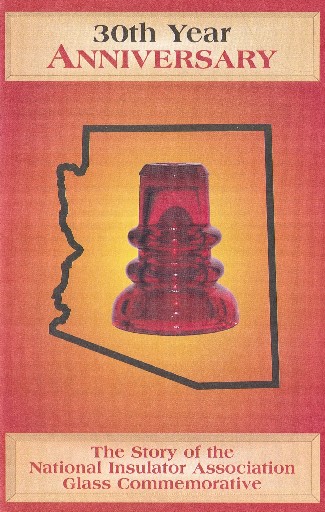
The commemorative insulator he designed replicated the
early threadless "pilgrim hat" (CD 736) and is almost 4 inches high
and 3-1/4 inches across at the base. Since 1970 the glass commemorative has
marked every national show with a new embossing and color for each location.
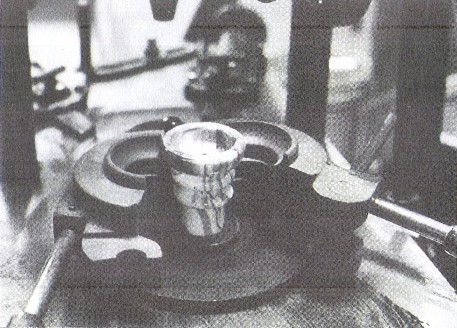
The Mould
Mr. Miller's mould consisted of two hinged halves, a base ring, and a
dome ring with two dome embossing disks. The embossing for the first national
meet was engraved on one of the dome embossing disks and the Second National Meet
information on the other.
The first two years were the only years that the
location and dates of the national show appeared on the dome. Because the
surface area is only about 2 inches in diameter, the embossing had to be
extremely small and, on many of the units, is faint and somewhat difficult to
read.
The Overmyer-Perram Company
After the location of the second national meet had been announced, Miller
prepared the mould to produce commemoratives for both the first and the second
national meets during the same production run. Mr. Miller contacted the
Overmyer-Perram Company, a glass manufacturer in Tulsa, Oklahoma, for the run.
Mr. Overmyer had worked at the Hemingray plant in his early years -- a real
"natural" to produce the first commemorative for the insulator hobby.
Overmyer-Perram's primary glass production color was a dark olive green black
glass. The company supplied glass block bases for fountain pen sets. Frank
contracted to have the commemoratives for the 1970 and 1971 national meets run
in Overmyer-Perram's dark olive green black glass and in apple green.
One day
Overmyer phoned Frank and told him he was running some of the commemoratives in
an experimental amber color. When Frank Miller arrived at the plant, he stopped
the production because he didn't like the looks of the amber. (The color was
really a straw, ginger ale color.) This is the reason so few commemoratives from
the first two years' runs are available in the straw color. The first two years
are the only years when three different colors were used.
When Frank and
Margaret Miller arrived in Colorado Springs for the second national meet, they
brought with them the commemoratives for the first and the second national meet
-- a surprise for the collectors assembled.
In July 1971, Dora Harned, editor of Insulators -- Crown Jewels o/the
Wire, wrote, "Frank says he will not make
any more of these (the first two national meet years), and he owns and possesses
the mould, although possibly he may later make them in a different color if he
can find a glass company interested in small orders." Dora went on to say,
"We predict these will become a collector's item in themselves, because
there just aren't enough to go around, and everyone who sees ours wants one,
even if they didn't attend the national meets."
The commemoratives for the
first two years were sold for $6.00 each plus postage. Frank Miller was not
interested in volume sales, but in giving the collector a chance to have a
beautiful memento of the national shows.
1970 Commemorative Embossing (on dome):
NEW CASTLE, INDIANA NAT'L MEET (outer
circle)
JUNE 20-21, 1970 FIRST (inner circle)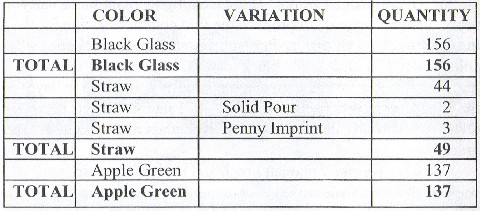
As the embossing ring for the dome of the 1971 commemorative was being
prepared, the engraver made an error in the dates. There are at least two known
examples of the commemorative that have the wrong show dates; a solid pour and a
regular insulator, both in the black glass color. The incorrect dates are
"July 11-12, 1971". Fortunately, the correct date was engraved and
production completed. What a disaster it would have been had the Millers arrived
at the second national meet with the incorrect dates on the souvenir glass insulator!
Three straw commemoratives from 1970 have domes
imprinted with a Lincoln penny. The coin was placed into the top of the mould,
and molten glass was added so the impression appears on top of the embossing.
The penny again "left its mark" on the domes of four insulators... two
are in black glass and two in straw.
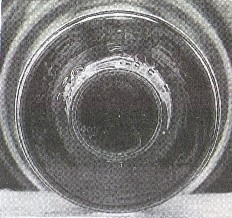
1970 Lincoln head imprint on the dome
of the first year's commemorative.
1971 Commemorative Embossing (on dome):
COLORADO SPRINGS, COLO. NAT'L MEET
(outer circle)
JULY 10-11, 1971 SECOND (inner circle)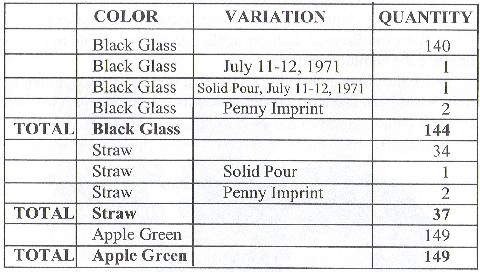
The St. Clair Glass Works
Since Frank exhausted all of Overmyer-Perram's three glass colors in the
manufacture of the first two years of commemoratives, he had to find another glasshouse to keep the tradition going. You
can't imagine how difficult it was to find a glasshouse willing to run
approximately 300 to 350 units of anything! Although in 1972 there was an
abundance of glasshouses throughout the midwest, Frank Miller was only able to
find one, the St. Clair Glass Works in Elwood, Indiana, willing to use his mould
to produce the commemoratives.
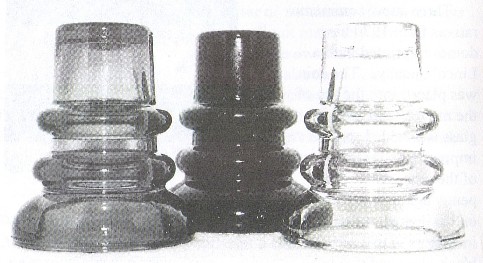
Apple Green, Black Glass and Straw colors for 1970 and 1971.
Since the dome embossing on the first two years
of commemoratives had been less than satisfactory, a decision was made to erase
all embossing from the dome ring and to use the base rim of the insulator to
mark the location and dates of the national show.
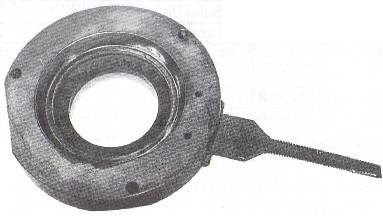
The Base-Embossing Ring
The embossing on the base rim was configured so the top line of embossing
faced the bottom line. This layout was used for all base rings used at St. Clair
Glass Works from 1972 through 1976.
During the production years at St. Clair
Glass Works, Frank Miller selected glass colors that were already being
produced at the factory. He never knew when the color selected for each year
would be run, but he would wait to receive a phone call from Joe St. Clair
saying that they were currently running the selected commemorative color and
"to get up to Elwood, Indiana, with the mould."
Frank would pack the
mould, which he stored in a specially designed and partitioned ammunition box,
into his Bronco, and he and Margaret would drive "sometimes
round-the-clock" in order to get to Elwood from their home in Tulsa.
Glasshouses don't like to have molten glass sit idle in a tank waiting to begin
production, so Frank and Margaret had to move quickly in order to make the
"production-time window" in the given color as dictated by St. Clair.
The 1972 color chosen for the production was a deep cobalt blue, but some
unusual "art pieces" were made -- all without the knowledge of Frank
Miller. The pieces look like they contain small pieces of multicolored cullet
thrown into a red glass or a green glass base. There are two known examples made with the red glass --
one perfect and the other cracked. Only one example in perfect condition is
known using a base color of green glass.
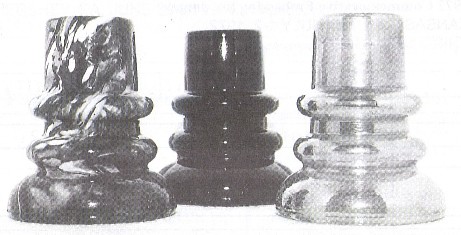
A handwritten note in the pinhole of the red speckled art glass piece
indicates
that it was purchased by Forrest Jones at an Ohio flea market (1972
mould);
1972 cobalt blue, 1972 mould carnival glass test for 1973.
There were two carnival pieces made;
one over the cobalt glass being used for the 1972 run, and one over clear glass.
Most glasshouses always have tanks of clear glass in operation. One can
visualize that an employee probably pulled and dropped clear glass into the
mould and then had the piece carnivalized. Apparently, employees were
"testing" to see what color they might suggest be used the following
year!
There were also two employees, "JOE MC" and "MIKE
MITCHELL", who left their embossing marks on the dome of a commemorative
during production. As easy as throwing a penny into the top of the mold, their
embossing dies were dropped into the mold and a commemorative was made. Only one
of each has been located. Neither of these units nor the "art glass
pieces" were authorized by Frank Miller. This is what can and does happen
in glasshouse production when employees enjoy making their own souvenirs! In
1972, the .price of the commemorative was raised to $7.00.
1972 Commemorative Embossing (on dome):
KANSAS CITY, MO. JULY 1-2, 1972
THIRD
NAT'L MEET (reverse rim)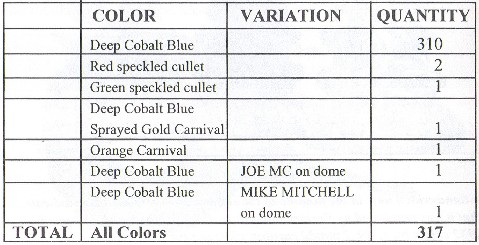
Within the last six months, two oddities from the 1973 run have been located.
There is a warming pour and an embossed unit in clear glass. Both were found
in the collection of an early collector and it is assumed that they were never
carnivalized. There has never been a solid pour located in carnival.
or any odd colors --produced that year. Probably two units just were never
treated and given by the Millers to a friend. No one would try to
"clean" a brand new carnival insulator in an acid bath, especially the
only known warming pour to exist.
1973 Commemorative Embossing:
FOURTH NAT'L MEET
HUTCHINSON, KANSAS JULY 7-8,
1973 (reverse rim)
1974 Commemorative Embossing:
NIA FIFTH NAT'L SHOW
HERSHEY, PA. JUNE 29-30 1974 (reverse rim)
During the 1975 run, when a red amberina glass was the chosen color, another
"souvenir" piece occurred during manufacture also, there were four
units sprayed with carnival. They have an incuse circular marking on the top of
the dome which reads "JOE ST. CLAIR" (pictured at right). The examples
were purchased at the St. Clair Glass factory and from an individual living in
Indiana.
The only ordered production color for 1975 was red amberina,
different from the 1999 ruby red glass since no gold chloride was used in the batch to stabilize the red color throughout the run. (Amberina
pressed into orange and yellow colors on the edges of the glass commemoratives.)
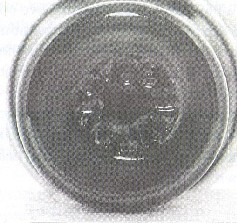
Dome with "JOE ST. CLAIR" marking
1975 Commemorative Embossing:
6TH NIA CONVENTION
SAN DIEGO, CA. JULY 11-13,
1975 (reverse rim)
Beginning with the 1976 commemorative, the embossing was in one continuous
clockwise circle. There seems to be no explanation as to why this change was made. It probably
was just the way the
engraver decided to machine the lettering.
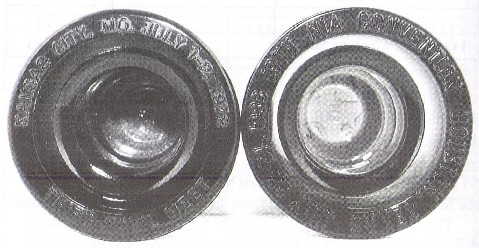
1976 Commemorative Embossing:
7TH NIA CONVENTION
BEREA, OHIO AUGUST 20-21,
1976 (reverse rim)
The Mosser Glass Company
In 1977 the midwest glasshouses were having to deal with the economics of the
shortages of natural gas. Most of the factories had to go with the high-volume
customers and refused to cater to entrepreneurs such as Mr. Miller who wanted to
have a small quantity of glass products run. As a result, Frank had to look for
another glass manufacturer. Frank related, "It was coming up on the
national show for 1977 which was to be held in Lakeland, Florida. We had
searched absolutely everywhere for a glass company willing to make the run. The
mould was ready, but no one was interested in our plight. Finally, Tommy Mosser
in Cambridge, Ohio, said, 'Yes.'" The Mosser Glass company has been the
production house for the commemorative since 1977, and still continues to cater
to the individual who wants to run a limited number of glass products. The cost
of the commemorative was $8.00 each in 1977 and was raised to $9.50 in 1978.
1977 Commemorative Embossing:
8TH NIA CONVENTION
LAKELAND, FLA. JULY 15-17
1977
1978 Commemorative Embossing:
9TH NIA CONVENTION
RENO, NEVADA JULY 21-23 1978
In 1979, Frank and Margaret Miller decided that the midnight runs to the
midwest glasshouse were more than they wanted to do, so they approached John and
Carol McDougald (then of Ohio) to buy their personal insulator collection and
the mould to make the national show commemoratives -- with the stipulation that
the McDougalds would continue to produce the commemoratives annually.
Continuation of Miller Commemorative by the McDougalds
"I guess that Frank thought that our location in Ohio would make it
easier for us to continue his project. He was confident that the Mosser Glass
Company would be willing to produce the insulator for us each year. Carol and I
accepted the challenge and have continued to work with Mosser each year,"
says John McDougald. "We are now forced to make the midnight runs from a
longer distance since our move to Illinois in 1989."
Entering the plant at
about 6:00 a.m., we found the morning run of glass using the amethyst color that
we had selected for the 1979 commemorative coming out of the cooling lehr. This
COULDN'T be the color we had selected. It was an ugly smoky gray! We had never
been involved in glass production of any kind before...and, we were in for some
interesting experiences during the 21 years of commemorative-making that have
followed since that first attempt at an amethyst glass."
Glassmaking is
terribly critical in nature. EVERYTHING has to be just right, or inconsistencies
can occur during production. The amethyst color had not held during the run due
to temperature and humidity fluctuations. So, when we received a call two weeks later, we
made the same journey back to the plant hoping that they had corrected the problem
and our commemoratives in amethyst would be the right color."
At
the 10th national show in Denver, Colorado, the-McDougalds arrived with the
commemoratives in a "burgundy amethyst" color. Frank and Margaret
Miller greeted the new color with approval and a vote of confidence that their
project would continue. At the same national show, the Millers were honored as
part of the group of seven men and women known as the "Lucky Seven".
The reason -- they had never missed a national show. Margaret and Frank Miller
were also honored awarded with a plaque from the National Insulator Association
for their Outstanding Contribution to the Hobby. It was a fitting tribute to
this fine couple's gift of glass --- a commemorative for the national shows.
1979 Commemorative Embossing:
10TH NIA CONVENTION
DENVER, COLORADO JULY 20-22
1979
| 